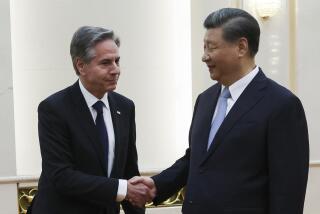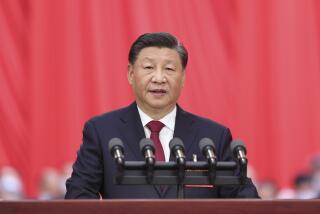China: THE GIANT WAKING : Witness to Remarkable Revolution : Peace Came, Then Success
- Share via
WASHINGTON — In China, the great revolution is in the streets. You watch it surging inexorably, overwhelmingly in the savage rush-hour traffic on Shanghai’s Huaihai Road, over the construction-filled skyline of the capital of Peking, along the pedestrian-filled passageways in the commercial labyrinth of Chengdu and in the villages of once-forgotten Central China where a new house seems to rise every minute on the minute.
The exuberant, peaceful Chinese revolution of the 1980s also lives triumphantly in the faces of well-fed, smiling children (the plague of poor countries’ gastric diseases has vanished); in the pride of rich farmers moving into new villa-like stone houses amid rice paddies and pig herds; in the explosion of color in the clothing of men and women; in the tender way a soldier and his fiancee hold hands by a lake near Xi’an; in the daring, intricate construction of dams for the rushing white-water gorges of Min and Dadu rivers out west, and, incongruously, in the waves of gaping foreign tourists (150,000 of them Americans this year) flowing into the billion-people ocean of Chinese humanity.
The xenophobia is gone; in China it is again fun to be an American. To watch from inside is a reporter’s dream; I saw China this fall with a group organized by Washington’s Population Institute--crisscrossed the country, talked around the clock in discussion and argument with stunningly open Chinese hosts.
Inevitably, this is an impressionistic portrait, but the most arresting impression is of a society finally at peace with itself--secure, optimistic. People are noisy and unregimented; traffic policemen are the only outward form of authority. I didn’t see a submachine gun anywhere.
But why? Why is China debt-free, prospering--the only workable communist system? My own conclusion--and many Chinese seemed to support it--is that an extraordinary convergence of historical and human events created the current situation.
Foremost: The Chinese appear to have been freed, for the first time since the civil wars of the 1930s, from constant political pressures and military tragedies.
The communist victory in 1949 ushered in an era of mammoth shortages and sacrifices as Mao Tse-tung sought to remold China, culminating in the bloody and still incomprehensible Cultural Revolution that destroyed much of an entire Chinese generation. Even now, people rarely discuss the Cultural Revolution; I think they are trying to forget Mao without actually tearing down his statues.
Credit Deng Xiaoping, who took power in 1979. The veteran of the “communist long march” a half-century ago has restored reason in government and launched the present revolution, perhaps the real revolution.
While Socialism remains China’s fundamental political framework, the chief conceptual reform is an economy now geared to market forces. Deng has invented “Marxism with a Chinese Face,” as this extraordinary social compromise is being called, and we witnessed the already visible and palpable results.
Television news and Chinese soap operas are sent by satellite; public criticism in print is invited, although there is no press freedom as we understand it. The English-language China Daily carries ads for American Express and foreign banks.
Deng’s achievements are in the world’s most populated nation and historically one of the most backward. The growing affluence and the smiles on Chinese faces are bound to make Marxist-Leninists from Moscow to Prague to Havana wonder why Chinese socialism is a success while theirs is failing.
Deng and his team manage their revolution in the absolute absence of any personality cult. There are no pictures of Deng anywhere; he carries only the title of chairman of a national association of retired persons, although he is the indisputable boss.
After the decades of the “Chairman’s Thoughts,” this must be a colossal relief. The hours of political education at Chinese universities have just been cut by half, which may be why, at Sichuan University, we saw young couples practicing dance steps at a pavilion between classes.
Because Deng and his friends have so mercilessly trampled Marxist-Leninist-Maoist doctrines, one may be tempted to wonder whether a counterrevolution by disgruntled ideologues is likely. The answer from a Peking editor (a graduate from the Missouri University School of Journalism) was no, not so long as the current system works so satisfactorily.
A Chinese scholar told me the nation is in the process of “xiaokang,” meaning “a relatively comfortable living standard,” having already left “jihan” (poverty) and now leaving “wenbao” (basic needs satisfied). A recent report by the World Bank concludes that the “speed and scale of the improvement is probably unprecedented in human history.”
Nowhere in China have I seen the kind of misery usually associated with Third World underdevelopment; the availability of food and the abundance of consumer goods are striking.
From the Great Wall (where you can buy T-shirts at the Great Wall Antiques Store) to the Forbidden Palace in Peking, tens of thousands of Chinese photograph each other--and their beloved children--with a Japanese-like passion. At small towns in Sichuan and Guanxi provinces, chattering crowds shop for colorful fabrics, color television sets, stereos, refrigerators, washing machines--almost anything a budding consumer’s heart might desire. The cities and villages are immaculately clean, despite the steady rhythm of construction.
Because of the emphasis on world economic ties and tourism, 50 new hotels are being erected in Peking in addition to office buildings for foreign companies (Shanghai does business with 18,000 firms in 160 countries). Air travel across the immensity of China by a Boeing 737 or 747 is increasing (including first class) as obsolete Soviet aircraft are being phased out.
But a challenge as great as modernization is population control. Through tough policies limiting families to one child per couple (at least in the cities), China hopes to limit the annual population increase to 10 million so that the total will stand at no more than 1.2 billion in the year 2000. Without such programs, the population within the next 14 years would reach 1.7 billion, a mass that could not be fed, housed or employed. On the scale of billions no problems are simple. Most likely, they will increase as China adopts new technology while so much of this vast land is still deep in the forgotten centuries--from Tibet to Inner Mongolia. Yet, one leaves China with a great sense of excitement and discovery, having just observed what is likely to be our century’s last real revolution.
More to Read
Sign up for Essential California
The most important California stories and recommendations in your inbox every morning.
You may occasionally receive promotional content from the Los Angeles Times.













